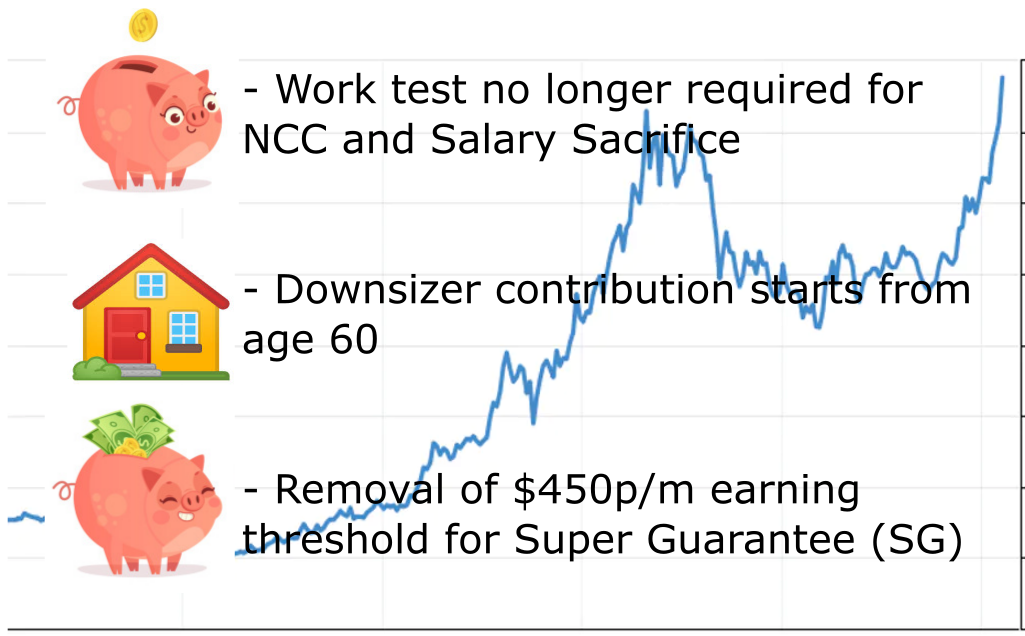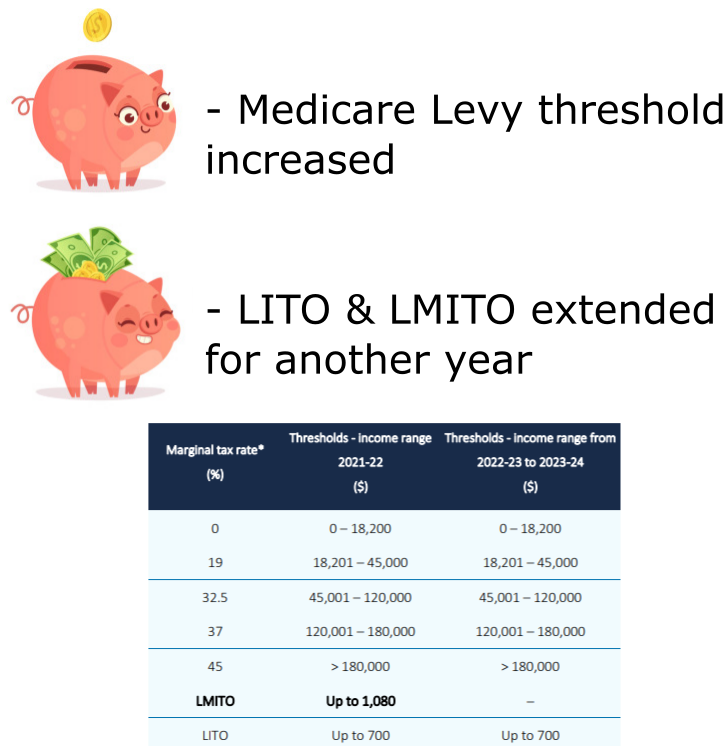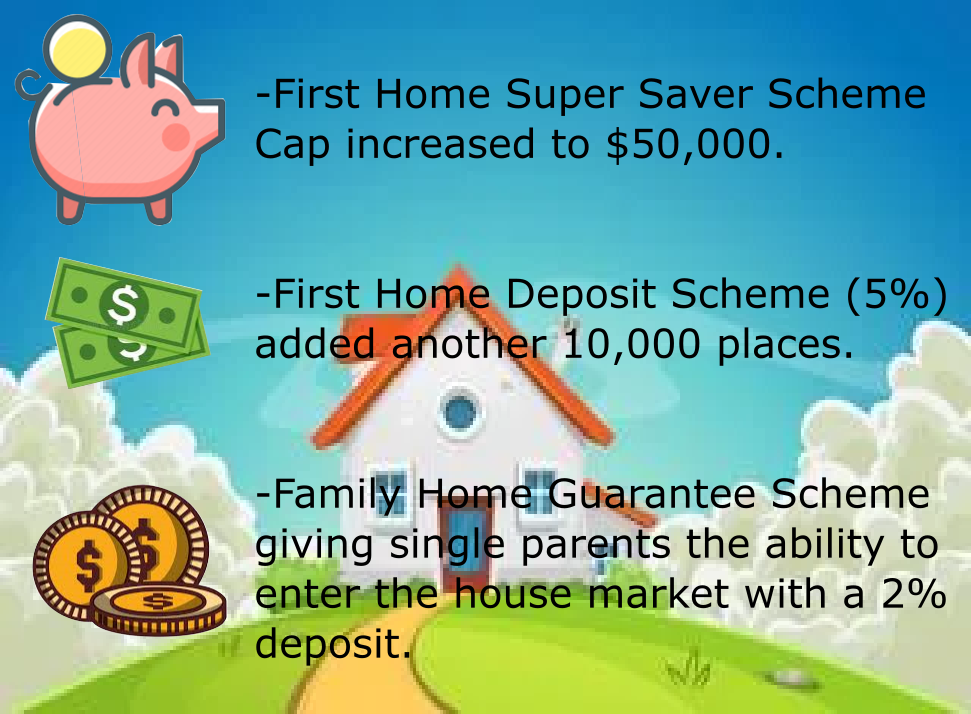Federal Budget 2021-22
Superannuation
1. Repealing the work test for super contributions
Proposed effective date: 1 July 2022
People aged 67 to 74 will be able to make non-concessional or salary sacrificed superannuation contributions without meeting a work test, subject to existing caps.
This will simplify super rules and increase flexibility for older Australians to save for their retirement.
Currently, people aged 67 to 74 years can only make voluntary contributions to their super if they’ve worked at least 40 hours
over 30 consecutive days in the financial year, unless they meet an exemption. The work test will still need to be met for those
who wish to claim a tax deduction for personal contributions to super.
2. Extending access to downsizer contributions
Proposed effective date: 1 July 2022
The Government is proposing to lower the age Australians can make tax-free contributions to their super from the proceeds
of selling their homes from 65 to 60.
Other eligibility rules for downsizer contributions will remain unchanged.
3. Giving retirees opportunity to exit legacy retirement products
Proposed effective date: 1 July after it’s passed as law
The Government will provide a temporary, two-year opportunity for people to transition from certain legacy
retirement products to newer, more flexible products if they choose.
Retirees will be able to transfer their capital back into a super account and then start a new retirement product, take a lump
sum benefit or retain the funds in that account.
4. Abolishing the $450 per month income threshold for Superannuation Guarantee (SG)
Proposed effective date: 1 July 2022
The minimum income threshold of $450 per month will be removed, so all eligible employees will receive
SG contributions. The SG rate is increasing to 10% from 1 July 2021 and then gradually to 12% by 2025.

Taxation – personal
1. Extending the Low and Middle Income Tax Offset (LMITO)
Proposed effective date: 1 July 2021
The LMITO was due to end on 30 June 2021 but will now be retained for one more year in 2021-22. It’s worth up to $1,080
for individuals or $2,160 for couples.
– The benefit for those earning up to $37,000 is $255.
– Between $37,000 and $48,000, the offset increases at the rate of 7.5 cents per $1 above $37,000 to a maximum of $1,080.
– Those earning between $48,000 and $90,000 are eligible for the maximum LMITO benefit of $1,080.
– For income above $90,000, the offset phases out at a rate of 3 cents per $1 and is not available when taxable income exceeds $126,000.
The Low Income Tax Offset (LITO) is also available and will be
reduced at a rate of:
– 5 cents per $1 for income between $37,500 and $45,000, and
– 1.5 cents per $1 for income between $45,000 and $66,667.
2. Increasing Medicare levy low-income thresholds
Proposed effective date: From 2020-21 financial year
Thresholds will increase from 1 July 2020 so low-income taxpayers will generally continue to be exempt from paying the Medicare levy.
The threshold for:
– singles will increase from $22,801 to $23,226
– families will increase from $38,474 to $39,167
– single seniors and pensioners will increase from $36,056 to $36,705
– families (seniors and pensioners) will increase from $50,191 to $51,094.
For each dependent child or student, the family thresholds increase by a further $3,597.

Housing Affordability
1. Extending the First Home Super Saver Scheme (FHSSS)
Proposed effective date: 1 July 2022
The cap on withdrawals of voluntary contributions will increase from $30,000 to $50,000. The FHSSS is aimed at
boosting the deposit savings of first home buyers by allowing them to use the tax advantaged super system.
The FHSSS allows first home buyers to withdraw voluntary contributions (both concessional and non-concessional) plus
an amount of notional earnings towards their first home purchase.
The total amount released from super cannot include more than $15,000 in voluntary contributions from any
one financial year, up to a total of $50,000 across all years plus associated earnings.
Read more about the First Home Super Saver Scheme by clicking here
2. Extending the First Home Loan Deposit Scheme (FHLDS)
Proposed effective date: 1 July 2021
An extra 10,000 new places in the FHLDS will be made available in 2021-22 to first home buyers who buy a newly constructed home or build a new home.
The FHLDS allows first home buyers/builders to borrow more than the standard 80% of the property’s value with only a 5% deposit and without paying lender’s mortgage insurance.
3. Helping Australians build and buy their homes
– HomeBuilder program
the Government will give people more time to take advantage of the grants by extending the construction commencement requirement from 6 to 18 months.
– Family Home Guarantee scheme
the Government will allow up to 10,000 eligible single parents with dependants to enter or re-enter the housing market with a deposit as little as 2% from 2021-22.

Families, Social Security and Aged Care
1. Increasing the Child Care Subsidy (CCS)
Proposed effective date: 1 July 2022
The Government proposes to provide a higher level of CCS to families with more than one child under age 6 and in child care to ease the cost of child care and remove the disincentives for parents to return to the workforce or increase their work hours.
The level of subsidy will increase by an extra 30% to a maximum of 95% for second and subsequent children.
Currently a family may receive a 50% subsidy on child care costs for each child if their family income is between $174,390 and $253,680. Under the proposal, the family would receive a CCS of 50% of costs for their first child and 80% for their second and subsequent children.
The annual cap of $10,560 for families earning between $189,390 and $353,660 will also be removed.
2. Improving the Pension Loan Schemes (PLS)
Proposed effective date: 1 July 2022
The Government is increasing the flexibility and attractiveness of the PLS by:
– introducing a No Negative Equity Guarantee so borrowers will never owe more than the value of their equity in the property the loan is secured against
– providing access to two lump sum advances in any 12 months up to 50% of the maximum annual rate of Age Pension.
The PLS enables senior Australians to receive fortnightly loan payments to supplement their retirement income by using their homes as security, provided the combined Age Pension payment and loan amount does not exceed 150% of the maximum pension payment rate.
Based on current Age Pension rates, a single person could receive lump sum payments of up to $12,385 per year, and couples about $18,670.25302 05/21
3. Supporting changes to aged care
Proposed effective date: Immediate and ongoing
The Government will deliver $17.7 billion to aged care over five years with a focus on home care as well as the sustainability, quality and safety of residential care.
Two immediate impacts will be the release of 80,000 new home care packages over two years from 2021-22 and improved daily living conditions in residential care by contributing $10 per day for each resident on top of the basic daily fee.

Trackbacks/Pingbacks